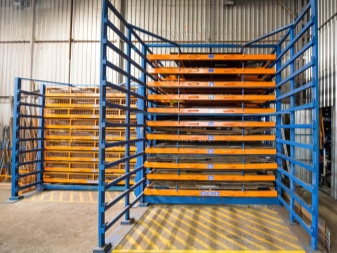Sheet metal storage racks

Sheet metal storage racks are used very often. It is necessary to understand the features of vertical and horizontal cassette racks for sheet materials, in the specifics of pull-out models. It is also worth paying attention to the nuances of practical choice.


Description
Racks for storing sheet metal in production and warehouses have been used for a long time. This is due precisely to the fact that the sheets occupy a significant area - it is very difficult to store them otherwise.
It is customary to design racks in such a way that all the necessary materials and types of metal blanks are placed on them.

You can easily vary the products in terms of thickness, type of alloy, and so on. When using shelving, you can count on:
-
the most rational use of useful warehouse space;
-
reduction in the number of employees required to perform the same job;
-
improving industrial safety;
-
acceleration of inventory;
-
acceleration of the turnover of material assets;
-
great safety of the used metal.


Views
The horizontal type of shelving ensures the most efficient use of useful space. It is highly appreciated in both warehouse and production sites.
You can vary the placement of the shelves initially, and sometimes even change it during use.


In most cases, the cassette type of shelves is practiced. Usually they are made retractable, but the use of fully removable structures is also quite feasible; for work, slings are used or even a loader equipped with a special device - a de-palletizer.
For vertical shelving, space is found mainly in warehouses with a small capacity or low intensity of metal materials turnover. But simple handling and compactness are guaranteed. There are two options for vertical shelving. The double-sided service type allows you to count on higher productivity.
In most cases, collapsible systems are used, which are convenient and versatile; you can order them for the profiled sheet.


Nuances of choice
A common mistake is to focus strictly on attractive appearance, completely ignoring considerations of mechanical strength, reliability and durability.
Many unscrupulous manufacturers try to use such public priorities to their advantage.

They make nice looking, but unreliable and short-lived designs. The negative aspects of their application are quite obvious. When studying a specific assignment, attention is paid to:
-
free space;
-
available space;
-
the specifics of work in a certain area;
-
the intensity of metal turnover.
The typical loading capacity of a rack is 15 tonnes in most cases. But if necessary, it can be easily decreased or increased.

It is necessary to further study:
-
height;
-
width;
-
load on individual sections;
-
total number of sections;
-
requirements of state and industry standards.















The comment was sent successfully.